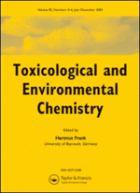|
Literature / Source Database:
Toxicological and Environmental Chemistry
| Title (short) |
Toxicol. Environ. Chem. |
| CODEN |
TECSDY |
| Languages |
English |
| First year |
1981 |
| Impact factor |
0.634 |
| Editor |
Hartmut Frank |
|
|

|
Status
active
Indexing
Biosis Previews, Biological Abstracts, Chemical Abstracts, SCOPUS and Toxnet.
Predecessor
Subject

Source type
Journal
Publisher
ISBN ISSN
0277-2248
E ISSN
1029-0486
First volume
3
Last volume
91+
Homepage
| Resources |
|
Availability |
|
|
|
|
|
| Text PDF |
 |
free access |
 |
| Text Html |
 |
for subscriber |
 |
| References |
 |
not available |
 |
| Abstracts |
 |
|
|
| TOC |
 |
|
|
|
|
|
|

Description
Toxicological and Environmental Chemistry is devoted to the general chemistry, environmental analysis, biochemical toxicology and ecotoxicology of xenobiotics and natural toxins. The journal is interdisciplinary in outlook, and manuscripts published in it cover all relevant areas:
- inorganic chemistry -- trace elements in food and the environment, complexes and metal chelates;
- organic chemistry - environmental fate, chemical reactions, metabolites and degradation products, synthesis of standards and labelled materials; physical chemistry -- photochemistry, radiochemistry;
- environmental chemistry - sources, fate, and sinks of xenochemicals, environmental partitioning and transport, degradation and deposition; analytical chemistry -- development and optimisation of analytical methods, instrumental improvements, miniaturisation and automation; biological chemistry
- pharmacology and toxicology, uptake, metabolism, disposition of xenochemicals, structure-activity relationships, modes of action, ecotoxicological testing.
Contributions to the journal include mainly original research manuscripts; reviews submitted or invited from experts in government, industry and universities are also published regularly. The xenochemicals considered are organic and inorganic air, water and soil pollutants, industrial pollutants, pesticides, food additives, drugs, natural toxins, radioactive materials, genotoxic compounds and persistent and/or bioaccumulative pollutants (POP's).
Related links:
|